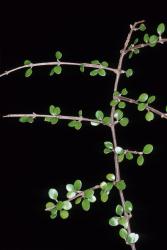- Taxon
- Gallery
Shrub up to c. 4 m tall, with ± interlacing, crooked branchlets. Bark fawn-brown, becoming moderately rough and furrowed on older branches and trunk. Branchlets diverging at a wide angle, often around 70-90°, dark red-brown to greyish brown, pubescent at growing tips but the hairs soon shed, decussately 2-angled, tbe longitudinal ridges sometimes retaining hairs but eventually becoming glabrous; intemodes of long shoots c. 1-2(-3) cm long. Short shoots opposite and decussate, each bearing 2-4 leaves and/or 1-5 capitula; older short shoots rough with closely packed leaf bases. Leaves opposite or in opposite fascicles, elliptic to suborbicular or broadly obovate to broadly spathulate; lamina c. 4 - 8(-10) × 3-6(-7) mm, upper surface bright glossy green when fresh, ± glabrous, smooth and flat, midrib above pale and not raised; main veins obscure; margins red or red-brown; lower surface silvery white with dense appressed tomentum, midrib beneath brownish and raised in proximal half, becoming obscure distally; apex obtuse, with a minute, brownish apiculus; base of lamina tapering abruptly to petiole. Petiole reddish, narrow-cuneately winged, c. (0.5—)1.5—3(—4) mm long with appressed tomentum beneath, glabrous or with sparse subappressed hairs above. Juvenile leaves similar but with a few darkened denticles on margins as well as at apex. Capitula in clusters of (1-)2-4(-5) on leafless or leafy short shoots, 6-7 mm long, scented. Peduncle 1-2 mm long, soft and flexible; bracts opposite, ovate, hairy, 1-1.5 mm long. Involucre cylindric to narrowly ovoid; involucral bracts spiralled, in three series, lanceolate to linear, bright green, the outer ones with a patch of silvery appressed tomentum near apex, inner glabrous; margins broad, red, fimbriate near apex of innermost involucral bracts, otherwise entire. Florets 4-5 per capitulum, outer 2-3 florets pistillate, with a very short erect or deflexed creamy white limb 0.8 mm long and yellowish stigma; inner 1-2 florets hermaphrodite, eligulate, with golden yellow anthers and dark reddish purple papillose stigma. Achenes narrowcylindric to narrow-obconic, brown with 4 pale ribs, sparsely hairy in distal quarter, 1.7-2 mm long; pappus hairs greyish white, slightly wavy, 2.5-3 mm long. FL: Oct. FR: Dec.
[Reproduced from Wilson & Garnock-Jones (1992, New Zealand J. Bot. 30: 365–368) with permission from The Royal Society of New Zealand.]




